Harare — MeerKAT, South Africa’s radio telescope, continues to produce significant new discoveries.
Using the telescope located in Meerkat National Park, in the Northern Cape, an international team led by a scientist from the University of Sydney has identified a peculiar neutron star that emits radio signals and rotates extraordinarily slowly, completing one cycle every 76 seconds.
PSR J0901-4046 is the name of the newly discovered neutron star that appears to have at least seven different pulse types, some of which are substantially periodic.
The team, led by members of the ERC-funded MeerTRAP (More Transients and Pulsars) group at the University of Manchester, claims it is a one-of-a-kind finding because it is located in the neutron star graveyard, where no radio emission is expected.
The discovery was published in the Nature Astronomy.
A single pulse was used to detect the star at first. Multiple pulses were then confirmed by comparing images of the sky taken at eight-second intervals, according to the scientific journal.
Neutron stars are the dense remnants of enormous stellar supernova explosions. There are approximately 3,000 of them in our galaxy, according to scientists.
The new discovery, on the other hand, is unlike anything else that has been discovered thus far. It may belong to the predicted class of ultra-long period magnetars, which are stars with exceptionally high magnetic fields, according to the scientists.
“Amazingly, we only detect radio emission from this source for 0.5% of its rotation period,” said research lead Dr. Manisha Caleb, formerly of the University of Manchester and now of the University of Sydney.
“This suggests that the radio beam’s intersection with the Earth was extremely fortunate. As a result, many more of these very slowly spinning stars are anticipated to exist in the galaxy, which has crucial consequences for understanding how neutron stars form and age,” Caleb said.
“The majority of pulsar surveys do not search for periods this long, so we have no idea how many of these stars might exist,” she said.
It has pulsar-like properties, ultra-long period magnetar-like properties, and even rapid radio bursts – brief flashes of radio emission in random sky locations.
“This is the beginning of a new class of neutron stars. How or whether it relates to other classes is yet to be explored. There are likely many more out there. We need only look.” Dr. Caleb said.
South Africa’s MeerKAT, originally the Karoo Array Telescope, which was inaugurated in 2018, is made up of 64 separate radio dishes that are 13.5m in diameter and spread out across an 8km region.
Until the Square Kilometre Array (SKA), which will be the world’s largest radio telescope, is complete, MeerKAT is the most sensitive radio telescope in the southern hemisphere.
Source link


